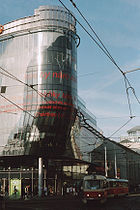
Smíchov
Encyclopedia


District
Districts are a type of administrative division, in some countries managed by a local government. They vary greatly in size, spanning entire regions or counties, several municipalities, or subdivisions of municipalities.-Austria:...
of Prague
Prague
Prague is the capital and largest city of the Czech Republic. Situated in the north-west of the country on the Vltava river, the city is home to about 1.3 million people, while its metropolitan area is estimated to have a population of over 2.3 million...
, the capital of the Czech Republic
Czech Republic
The Czech Republic is a landlocked country in Central Europe. The country is bordered by Poland to the northeast, Slovakia to the east, Austria to the south, and Germany to the west and northwest....
, and is part of Prague 5
Prague 5
Prague 5, formally the Prague Municipal District , is a second-tier municipality in Prague. The administrative district of the same name consists of municipal districts Prague 5 and Slivenec....
. It is located on the west bank of the Vltava
Vltava
The Vltava is the longest river in the Czech Republic, running north from its source in Šumava through Český Krumlov, České Budějovice, and Prague, merging with the Elbe at Mělník...
(Moldau) river.
Between 1945 and 1989, the district contained a monument dedicated to Soviet tanks
Monument to Soviet tank crews
Monument to Soviet Tank Crews was a World War II memorial located in Prague. It is also known as the Pink Tank, because it was controversially painted pink, first by artist David Černý, and several times thereafter.The original location of the monument was .- The monument :The monument, originally...
in World War II
World War II
World War II, or the Second World War , was a global conflict lasting from 1939 to 1945, involving most of the world's nations—including all of the great powers—eventually forming two opposing military alliances: the Allies and the Axis...
, which was located in Štefánik square. The monument was removed shortly after the Velvet Revolution
Velvet Revolution
The Velvet Revolution or Gentle Revolution was a non-violent revolution in Czechoslovakia that took place from November 17 – December 29, 1989...
and a new glass-and-steel building designed by French architect Jean Nouvel
Jean Nouvel
Jean Nouvel is a French architect. Nouvel studied at the École des Beaux-Arts in Paris and was a founding member of Mars 1976 and Syndicat de l'Architecture...
became a symbol of the district. An angel (anděl in Czech
Czech language
Czech is a West Slavic language with about 12 million native speakers; it is the majority language in the Czech Republic and spoken by Czechs worldwide. The language was known as Bohemian in English until the late 19th century...
) from Wim Wenders
Wim Wenders
Ernst Wilhelm "Wim" Wenders is a German film director, playwright, author, photographer and producer.-Early life:Wenders was born in Düsseldorf. He graduated from high school in Oberhausen in the Ruhr area. He then studied medicine and philosophy in Freiburg and Düsseldorf...
' movie Wings of Desire
Wings of Desire
Wings of Desire is a 1987 Franco-German romantic fantasy film directed by Wim Wenders. The film is about invisible, immortal angels who populate Berlin and listen to the thoughts of the human inhabitants and comfort those who are in distress...
is etched into the glass on the façade. The building was demolished in the 1980s and a metro station was built in its vicinity; the local traffic hub was renamed to Anděl from Moskevská (after Moscow
Moscow
Moscow is the capital, the most populous city, and the most populous federal subject of Russia. The city is a major political, economic, cultural, scientific, religious, financial, educational, and transportation centre of Russia and the continent...
). The Staropramen
Staropramen
Staropramen Brewery is the second largest brewery in the Czech Republic, situated in the Smíchov district of Prague. It was founded in 1869 and the brand name Staropramen, literally meaning “old spring,” was registered in 1911...
brewery is located in Smichov.
The Ringhoffer factory, founded in 1852 by railway magnate Baron Franz Ringhoffer (1817-1873) and nationalized after World War II, was part of one of the largest industrial enterprises of the Austro-Hungarian Empire (and later of Czechoslovakia
Czechoslovakia
Czechoslovakia or Czecho-Slovakia was a sovereign state in Central Europe which existed from October 1918, when it declared its independence from the Austro-Hungarian Empire, until 1992...
). The Ringhoffer Works with more than 30.000 employees played a significant role in central European economy with global relevance, exporting railway carriages, cars (Tatra) and trucks across the world. The factory in Smíchov produced court trains and famous saloon cars for European rulers und after 1945 trams for the entire Eastern bloc
Eastern bloc
The term Eastern Bloc or Communist Bloc refers to the former communist states of Eastern and Central Europe, generally the Soviet Union and the countries of the Warsaw Pact...
. It was moved to Zličín in the 1990s and is now operated by Siemens
Siemens
Siemens may refer toSiemens, a German family name carried by generations of telecommunications industrialists, including:* Werner von Siemens , inventor, founder of Siemens AG...
. The buildings were demolished and replaced by a hypermarket, two multiplex cinemas, two hotels and several other commercial structures.
After the first world war the company based in Bohemia and Moravia hold strong positions in Czechoslovak heavy metal industries. Under occupation by Nazi Germany the "Ringhoffer-Tatra" concern, consisting of wagon, automobile and electro-technical factories principally in Prague-Smíchov and Studenka (wagon construction), Koprivnice (Tatra-automobiles), Kolin and Ceska Lipa, succeeded in holding together despite attempts of the Hermann-Göring-Werke to absorb it. This struggle required a certain level of cooperation with the authorities of the "Third Reich". Ringhoffer-Tatra was nationalized and dissolved after the liberation and restoration of Czechoslovakia in 1945. The last owner and general manager, Baron Hans (Hanus) Ringhoffer (1885-1946) died one year later in detention, the family was expelled without compensation.
Founder of the firm was the coppersmith and inventor Franz Ringhoffer (1744-1827), native of Müllendorf (nowadays in the Austrian province of Burgenland near the Hungarian border), who arrived in Prague in 1769. He set up his workshop in the Old Town and produced brewery pans besides distillery and agrarian technical equipment. His son Joseph (1785-1847) established a hammer mill in Kamenice and extended the business by adapting it to the manufacture of special products for sugar factories and distilleries. Joseph's son Franz (II) (1817-1873), the first Baron Ringhoffer, obtained by government decree a concession for the manufacture of all categories of metal work and machinery for the whole country. He perceived the opportunity offered by railway development and started in 1852 the production of vehicles in Smichov, where he added an iron-foundry. The Works became the largest rolling-stock factory in the former Austrian Empire and then in Czechoslowakia.
Smíchov in the Arts
- 1995 – an escalator scene from SvěrákJan SverákJan Svěrák is a Czech film director. He is the son of screenwriter and actor Zdeněk Svěrák. He studied documentary filmmaking at the Academy of Performing Arts in Prague...
's KolyaKolyaKolya is a 1996 Czech film drama about a man whose life is reshaped in an unexpected way. The film was directed by Jan Svěrák and stars his father Zdeněk Svěrák who also wrote the script from a story by Pavel Taussig.- Synopsis :...
was shot in Smíchov. - 1999 – Vladimír MichálekVladimír MichálekVladimír Michálek is a Czech film director and screenwriter.- Life :Michálek graduated from Czech film Academy FAMU, Prague, in 1992. Starting during his academic study he was filming documentaries...
's movie Angel Exit featured among others the half built Jean Nouvel building, the abandoned Jewish synagogue, the half-demolished Ringhoffer factory, St Wenceslas Church and the Bertramka cemetery.
People
- Karl Egon EbertKarl Egon EbertKarl Egon Ebert was a Bohemian German poet, born in Prague.His poems, dramatic and lyric, are collected in 7 volumes, and enjoy a wide popularity in his country. He composed a poem called "Das erste Veilchen", or "The First Violet", which was set to music by Felix Mendelssohn....
, poet - Moses Porges von PortheimMoses Porges von PortheimMoses Porges, Edler von Portheim, or Moses Porges von Portheim was a Czech-Austrian industrialist and vice-burgomaster of Prague-Smichow; knight of the Order of Francis Joseph....
, a Jewish mayor - Baron Franz (Frantisek) Ringhoffer (1817-1873), founder of the factory, mayor of Smichov
- Marie Jana Korbelová on May 15, 1937 otherwise known as Former Secretary of State (January 23, 1997 – January 20, 2001) Madeleine Korbel Albright
- Rayko DaskalovRayko DaskalovRayko Ivanov Daskalov was a Bulgarian interwar politician of the Bulgarian Agrarian People's Union . One of the chief leaders of the republican Vladaya Uprising organised by deserted Bulgarian Army troops in 1918 against the government, from 1919 to 1923 Daskalov was a prominent member of the...
(1886–1923), Bulgarian agrarian politician, was assassinated by an Internal Macedonian Revolutionary Organization (IMRO) associate in Smíchov
See also
- Railway line Prague-Smíchov–HostiviceRailway line Prague-Smíchov–HostiviceThe Smíchov - Hostivice railway line or Prague Semmering is a railway line in the Czech Republic. The line was built in 1868–1872 by the Buštěhrad Railway company as part of its connection between Prague and Chomutov....

